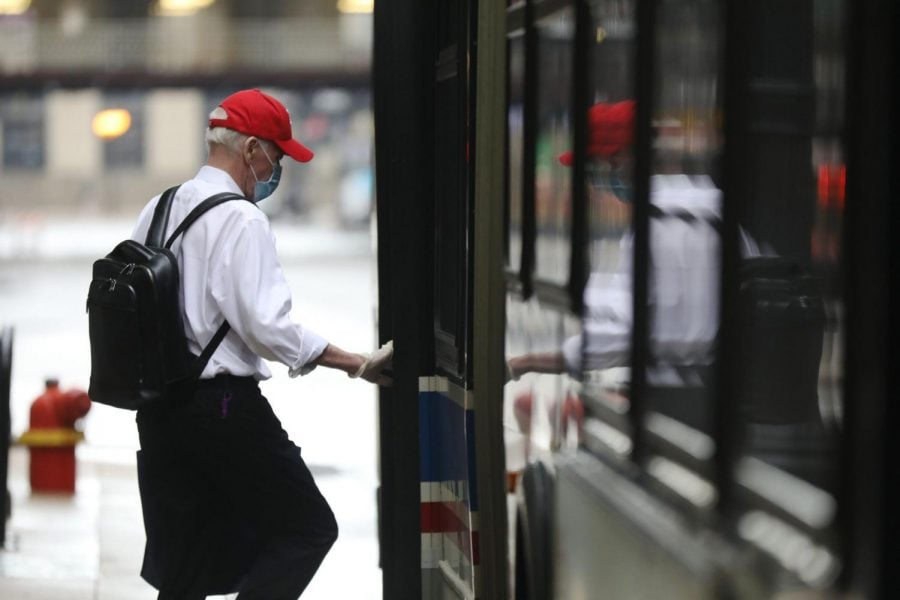CTA grapples with fallout from COVID-19
A CTA passenger boards a 151 Sheridan bus on West Adams Street, May 14, 2020. Since the start of COVID-19, Chicago public transit systems have seen significant decreases in ridership.
May 27, 2020
As Chicago prepares to take steps to reopen the city, public transportation has faced unprecedented drops in ridership since the beginning of the COVID-19 pandemic.
City officials have identified public transportation as essential for residents in their return to work. To restore confidence in their services, the Chicago Transit Authority and other Chicago public transportation networks will emphasize the safety of both its workforce and commuters.
The three public transportation authorities that serve Evanston — the Metra, CTA and the Pace bus system — have almost entirely maintained service, even with sharp declines in usage. Metra, CTA and Pace Bus have seen drops in ridership by 96, 88 and 69 percent, respectively.
Jessica Hyink, the city’s transportation and mobility coordinator, said she is communicating any service changes caused by COVID-19 with transit operators and residents. Right now, Hyink said all Evanston transit operators, other than Metra, are operating with full service.
“Pace has begun reducing service and cancelling routes in other communities, but fortunately Evanston has not had any Pace service reductions at this time and CTA has not reduced service at all,” Hyink said.
Though Evanston public transportation continues to operate, Hyink said residents should avoid using public transportation if they are not essential workers. She added that those who must ride should maintain social distance.
For many transit workers and commuters, safety is a major concern. Essential workers, including healthcare workers, often depend on safe and reliable transportation to get them to work.
W. Robert Schultz III, campaign organizer for Active Transportation Alliance, an organization that works with Chicago officials and community leaders to advocate for equitable and sustainable transportation, said COVID-19 has heightened the organization’s mission.
“We had a discussion internally, and the most important thing to do is to lift the needs of essential workers who are traveling, and to lift the needs of neighborhoods that are most impacted by COVID-19,” Schultz said.
Referencing heat maps based on cell phone data, Schultz said North Side residents are largely staying home, while those who live on the South Side, many of whom are essential workers, are traveling at higher rates.
Shultz said the ATA has successfully encouraged the CTA to take steps to protect drivers — plans that previously didn’t exist. The CTA is ensuring an adequate number of buses are deployed to the South Side to allow for social distancing, among other preventative health measures.
Since May 19, five CTA workers have died of COVID-19. In comparison, nearly 130 Metropolitan Transit Authority workers have died in New York City, according to some estimates.
One of the biggest hurdles facing Chicago public transportation, however, is funding. The Regional Transit Authority, which oversees Metra, CTA, and Pace, expects a 28.5 percent decrease in sales tax revenue in 2020, a main revenue source for the RTA.
Chicago transit services will receive $1.4 billion from the CARES Act, which is not predicted to cover the long-term fallout from COVID-19. In March, CTA president Dorval R. Carter, Jr. joined other transit agencies from across the country in sending a letter to Congress to request that at least $25 billion be included in the CARES Act for public transportation.
“The challenge for the CTA is how to navigate these turbulent budget times and improve confidence for people to return,” Schultz said. “Hopefully the CTA can partner with other agencies to extend its reach to help provide jobs, and can be more proactive in planning for what we can anticipate.”
Email: [email protected]
Related Stories:
— Legislators pass a $40 billion state budget, count on federal help
— State revenue shortfalls to impact human services and education; Pritzker calls on Congress for aid
— City could lose up to $20 million in revenue


